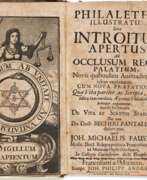Doctors 17th century


Johann Hartmann Beyer was a German physician, mathematician and statesman.
He earned a master's degree in liberal arts at the University of Strasbourg, and then graduated from the University of Tübingen with a doctorate in medicine. In 1588 Beyer returned to his native Frankfurt and began working as a physician; a year later he was appointed Physicus ordinarius - his duties included overseeing the city's health care and pharmacy system.
In 1614 Beyer took up the position of senior burgomaster of Frankfurt, but during the Fetmilch Rebellion he became involved in conflict, was forced to resign and returned to science.
He had the richest library of scientific books, numbering about 2500 volumes, wrote scientific works on astronomy and mathematics, engaged in medical activity, having invented the famous Frankfurt pills. Beyer carried on a lively correspondence with scientists, including mathematician Johannes Kepler, dealing with decimal fractions. Beyer bequeathed his rich inheritance to the city and to charity.


Giovanni Alfonso Borelli was an Italian universalist scientist of the 17th century Scientific Revolution, the founder of biomechanics.
He studied mathematics under Benedetto Castelli (1577-1644) in Rome. In the 1640s Borelli was appointed to the chair of mathematics at the University of Messina and at Pisa in 1656. After 12 years at Pisa and numerous disputes with colleagues, Borelli left the university. In 1667 Borelli returned to the University of Messina, where he engaged in literary and historical studies, studied the eruption of the volcano Etna, and continued to work on the problem of muscular movement of animals and other bodily functions according to the laws of statics and dynamics. In 1674 he was accused of participating in a conspiracy to liberate Sicily from Spain and fled to Rome.
Borelli is known primarily for his attempts to explain muscular movement and other bodily functions according to the laws of statics and dynamics. His best-known work is De Motu Animalium (1680-81; "On the Motion of Animals"). Borelli calculated the forces required for balance in the various joints of the human body, long before Newton published his Laws of Motion. Borelli was the first to realize that musculoskeletal levers increase motion, not force, so muscles must produce much greater forces than those that resist motion. He was also one of the first microscopists: he made microscopic studies of blood circulation, nematodes, textile fibers, and spider eggs. Borelli also authored works on physics, medicine, astronomy, geology, mathematics, and mechanics.


Edward Browne was a British physician, president of the College of Physicians, traveler, historian and writer.
Edward was the eldest son of the famous British scientist Sir Thomas Browne (1605-1682), received a Bachelor of Medicine degree from Cambridge later and a Doctor of Medicine degree from Oxford, and became a member of the Royal Society. In addition to medicine, his subjects of study included botany, literature, and theology. He lived in London and traveled throughout Europe visiting museums, churches, and libraries (Italy, France, the Netherlands, and Germany). In 1673 he published an account of his travels in Eastern Europe, notable for its scrupulous accuracy.
Edward Browne also published two other works: a historical treatise and biographies of Themistocles and Sertorius. He was physician to King Charles II of England and left many manuscript notes on medicine. The chronicle of his journey through Thessaly is a unique and valuable source of information about the region in the second half of the 17th century. He was admitted to the College of Physicians in 1675 and served as its president from 1704 to 1708.


Pierre Chirac was a French physician and chief physician to Louis XV.
Chirac received his Doctor of Medicine degree from Montpellier in 1683, and three years later became professor of medicine. He was elected a member of the Academy of Sciences in 1716, became head of the Royal Garden of Medicinal Plants in 1718, and was appointed physician to Louis XV in 1731. In the 1690s Chirac selflessly and successfully engaged in the treatment of rampant at that time dysentery, yellow fever, smallpox.
Pierre Chirac was one of the leading physicians of his time; with an inquisitive mind, he was interested in several fields of medicine. In 1692, he wrote a significant treatise on cardiology.
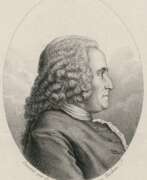

Denis Dodart was a French botanist, naturalist and physician.
Dodart studied at the University of Paris, received a doctorate in medicine and was already in his youth known for his erudition, eloquence and open-mindedness. In 1673 he was elected to the French Academy of Sciences.
He is known for his early studies of plant respiration and growth. Dodart collaborated with the French engraver Nicolas Robert to illustrate his botanical works.
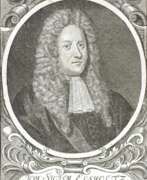

Johann Sigismund Elsholtz (also Elßholtz, Elßholz, Elsholz, Latin Elsholtius) was a German physician, botanist and chemist, a pioneer of hygiene.
Elsholtz studied at the universities of Wittenberg, Königsberg, and Padua, where he received his doctorate. In 1654, he published Anthropometry, written for artists and astrologers as well as students of medicine and physiognomy. The book also explored the supposed relationship between the proportions of the human body and morbidity. Elsholtz was a very versatile scientist and worked in the fields of horticulture, botany, alchemy, astrology, dietetics and medicine, among others.
Elsholtz was later appointed court botanist, alchemist and physician to Elector Friedrich Wilhelm of Brandenburg (1620-1688), and in 1657 was placed in charge of his botanical gardens in Berlin, Potsdam and Oranienburg. In 1672 his treatise Vom Garten-Baw: Oder Unterricht von der Gärtnerey auff das Clima der Chur-Marck Brandenburg was published in Berlin. ("From the Garden Bow or Lessons in Gardening in the Climate of Chur-Marck Brandenburg." It presents the latest gardening techniques for the German climate, discussing flower gardens and their design, vegetable gardens, medicinal gardens, and vineyard care and design.
Elsholtz was a German pioneer in the field of cleanliness and nutrition. Generally speaking, the term "hygiene" first appeared in German in 1682 in his Dietetikon. It is the term he uses to describe the principle of maintaining good health. In his book, the doctor makes recommendations for healthy eating and drinking. He calls for clean water and good air and emphasizes the importance of personal hygiene. Elsholtz was one of the first to administer intravenous injections to people around 1665.


Girolamo Fabrici d'Acquapendente, also known as Girolamo Fabrizio or Hieronymus Fabricius, was an Italian anatomist and surgeon and the founder of embryology. The Latinised form of his name, under which his works can be found, is Hieronymus Fabricius (ab Aquapendente).


Wilhelm Fabry von Hilden or Fabricius von Hilden (Latin: Fabricius Hildanus) was a German and Swiss Renaissance physician and surgeon, the founder of scientific surgery.
In 1576 he began a four-year apprenticeship as a surgeon with a barber in Neuss. Surgery at that time was considered the craft of bath and barbers; surgeons or wound doctors treated wounds, broken bones, inflammations, and many other ailments. After completing his apprenticeship, Fabry worked for five years as an assistant wound surgeon to Cosmas Slot (died 1585) at the court of Duke Wilhelm V in Düsseldorf. To expand his anatomical knowledge, Fabry constantly dissected and prepared cadavers. In later years, he also encouraged his students to do so and conducted public autopsies to draw attention to the importance of anatomical knowledge. He also made it a habit to do practice procedures on a cadaver before surgery.
In 1615 Fabry was appointed city physician of Bern. Here he wrote several books on gunshot wounds. In 1623 the versatile physician published a small book, "Christian and Good-Hearted Caution against Drunkenness," which he republished in more detail the following year under the title Christlicher Schlafftrunck. Fabry's most important surgical treatise was Observationem et curationem chirurgicam centuriae sex ("Six hundred surgical observations and cures"), first published in 1606. This compilation remained the most important book of German surgery until Lorenz Heister. It describes new surgical methods and surgical instruments for the treatment of amputations, nasal polyps, bladder stones, dropsy, hernias, ascites, etc., etc., etc.
For centuries, Fabricius remained one of the most respected surgeons not only in Germany and Switzerland, but throughout Europe. Among his many accomplishments in the field of surgery may be enumerated his innovation in the amputation of the thigh, for which he invented a special tourniquet; the excision of involved axillary glands in breast cancer; the first classification of burns into three degrees with the appropriate treatment for each variety; and the first description of a medical field chest for military purposes.
Although in his later years Fabritius had already given up practicing medicine, he continued to write medical papers and maintain an active scientific correspondence until his death. He authored some 20 medical books. It was his surgical works, translated into German, French, Latin, English and Dutch, that ensured his recognition centuries later.


Robert Fludd was a prominent English Paracelsian physician with both scientific and occult interests. He is remembered as an astrologer, mathematician, cosmologist, Qabalist and Rosicrucian.
Fludd is best known for his compilations in occult philosophy. He had a celebrated exchange of views with Johannes Kepler concerning the scientific and hermetic approaches to knowledge.


Girolamo Franzosi was an Italian physician and philosopher.
He was born in Polpenazza (now Polpenazze del Garda), near the Lombard lakeshore, in the late sixteenth and early seventeenth centuries. Franzosi was a student at Padua and became a convinced Aristotelian. He opposed the anatomists of the Neoteric Academy, which represented the new trends of medicine in Verona in contrast to the Galenic tendencies of traditional medicine.
Franzosi's other works, written under the influence of Girolamo Cardano and Agostino Nifo, deal with such wide-ranging topics as dreams, prophecies, imagination, and the medicinal properties of viper venom. He printed most of his works in Verona, calling himself "medicus and philosopher of Verona".


William Gilbert was a British physicist and medical scientist famous for pioneering the study of magnetic and electrical phenomena.
After receiving a medical degree, Gilbert settled in London and began his research. In his major work De Magnete, Magneticisque Corporibus, et de Magno Magnete Tellure (On Magnetic Stones and Magnetic Bodies and the Great Magnet of the Earth), published in 1600, the scientist describes in detail his studies of magnetic bodies and electric attraction.
After years of experimentation, he came to the conclusion that the compass arrow points north-south and downward because the Earth acts as a rod magnet. He was the first to use the terms electric attraction, electric force, and magnetic pole. Gilbert came to believe that the Earth rotates on its axis and that the fixed stars are not all the same distance from the Earth, and believed that the planets are held in their orbits by magnetism.


Jacques Guillemeau was a French pioneering surgeon, obstetrician and ophthalmologist.
Born into a family of prominent Orleans physicians, he received a classical education and moved to Montpellier at the age of 21 to study medicine. With the support of his father, a respected surgeon at the court of the French king, Jacques Guillemeau studied under the country's leading physicians. In 1569 Guimault moved to Paris, and in 1574 he succeeded his teacher and royal surgeon Ambroise Paré (1510-1590). Guillemeau assisted Dr. Paré during the war in France and Flanders (1576-1580), and from 1581 he performed surgical operations at the Hotel Dieu hospital in Paris.
During his long career, Dr. Guillemeau earned a reputation as a skilled and experienced surgeon, also publishing several works that gave him a prominent place in the medical community of his time. In 1584, Guillemeau published his "Treatise on Eye Diseases", and in 1585, his "Treatise on the Ailments of the Soul". In 1609, his groundbreaking book "Happy Childbirth in Women" was published. And his "Works on Surgery", written for young surgeons, were regularly reprinted until the middle of the 17th century.


William Howe or How was a British botanist and physician.
He studied at St. John's College, Oxford, earning a bachelor's degree and then a master's degree in medicine. He served briefly in the King's army as a cavalry commander, and later returned to the medical profession and practiced in London.
In his Phytologia Britannica, natales exhibens Indigenarum stirpium sponte Emergentium ("Phytology Britannica"), published in London in 1650, William Howe combined Thomas Johnson's catalogs into a single alphabetical list, supplemented with additional plants from other sources. This was the first edition of the book to compile for the first time all the known plants of Britain with descriptions of their occurrence.


Fortunio Liceti (Latin: Fortunius Licetus) was an Italian physician, natural philosopher, writer and educator.
Liceti studied philosophy and medicine at the University of Bologna and earned doctorates in these disciplines. He taught logic and philosophy at the University of Pisa, and became professor of philosophy at the University of Padua and the University of Bologna. At the University of Padua, Liceti became friends with Galileo Galilei.
Liceti's inquisitive mind was interested in a wide range of subjects: from genetics and reproduction to gems and animals. In general, Fortunio Liceti was a very industrious and prolific scientist: he published a book each year, writing more than seventy works on a wide range of subjects, including the human soul, reproduction, and birth defects.
In 1616, Liceti wrote and published the first edition of De monstruorum causis, natura et differentiis (On the Causes, Nature, and Differences of Monsters), a chronologically ordered catalog of monsters from antiquity to the seventeenth century. Among these monsters were infants with congenital malformations. Liceti was one of the first scholars to attempt to systematically categorize birth defects according to their causes, including numerous causes not related to the supernatural. This topic interested the scientist greatly and he returned to it several times during his life, supplementing it with illustrations, among other things. From 1640 to 1650. Liceti also wrote and published seven different volumes in which he answered questions from famous people on a wide variety of medical topics.


Martin Lister was a British naturalist and physician.
It could be argued that Lister founded two fields of natural history: arachnology (the study of spiders) and conchology (the study of the shells of organisms). He wrote more than 60 articles in the Philosophical Transactions of the Royal Society of London, published several volumes on natural history, speculated on the mysterious nature of fossils, and was successful as a physician.
Lister employed his artist daughters to illustrate his books on insects and molluscs - the names of Susanna and Anne appear on the title pages of the volumes. The Lister family published Historiæ Conchyliorum between 1685 and 1692.
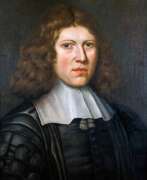

Richard Lower was a British physician, anatomist and physiologist who developed methods of blood transfusion.
Lower studied medicine at Oxford, moved to London in 1666 and began practicing medicine, soon becoming a successful physician and a Fellow of the Royal Society. Lower is particularly known for his work on the brain and nerves, which he performed as an assistant to Thomas Willis at Oxford while studying medicine. His anatomical and physiological study of the structure and action of the heart was one of the earliest discoveries, and he himself was recognized as one of the most skilled vivisectors of his time.
Lower was involved in the earliest experiments in blood transfusion, following Christopher Wren's similar studies a few years earlier. In February 1665, Lowther performed the first transfusion of blood from an artery of one animal into a vein of another, and in 1666 he also participated in the first experimental transfusion of blood to man.
Lower was a pioneer of experimental physiology. In his book Tractatus de Corde (1669), he described his pioneering work on blood transfusion and the function of the cardiopulmonary system. Also described is a series of experiments conducted with Robert Hooke in which he showed that the color of arterial blood is due to its contact with "fresh air" in the lungs.


Marcello Malpighi was an Italian biologist, anatomist and physician, professor of logic, theoretical and practical medicine, and a member of the Royal Society of London.
After graduating from the University of Bologna with the degree of Doctor of Medicine and Philosophy, Malpighi soon took up a professorship there, then taught at the universities of Pisa and Messina. At the same time as teaching, he conducted biological research with his microscopes, which was an innovation in those days. In 1661, he identified and described the pulmonary and capillary network connecting small arteries to small veins, one of the most important discoveries in the history of science. He also isolated taste buds and regarded them as nerve endings, described the minute structure of the brain, the optic nerve, and in 1666 was the first to see red blood cells and attribute to them the color of blood. His treatise De polypo cordis (1666) explained the composition of blood and how it coagulates.
During his medical practice, Malpighi studied microscopic sections of the liver, brain, spleen, kidneys, and the bone and deep layers of skin that now bear his name. In his landmark 1673 work on the embryology of the chicken, the scientist concluded that the embryo forms in the egg after fertilization. In 1675-79 he also made extensive comparative studies of the microscopic anatomy of several different plants and saw analogies between plant and animal organisms. The Royal Society of London published two volumes of his botanical and zoological works in 1675 and 1679. His Anatome Plantarum is richly decorated with engravings by Robert White.
After his house was burned and looted by his adversaries, in 1691 Pope Innocent XII invited him to Rome as papal personal physician, which was a great honor.
Malpighi can be considered the first histologist. For almost 40 years he used the microscope to describe the main types of plant and animal structures and thus marked for future generations of biologists the main directions of research in botany, embryology, human anatomy and pathology. The conflict between ancient ideas and modern discoveries continued throughout the seventeenth century. Malpighi was convinced that microscopic anatomy, by showing the minute structure of living things, questioned the value of the old medicine. He laid the anatomical foundation for the subsequent understanding of human physiological exchanges.


Christopher Merrett was a British physician and natural scientist.
Merrett was somewhat of a polymath and natural philosopher. His interests ranged from coinage and tin mining in Cornwall to glassblowing and butterfly taxonomy (his Pinax Rerum Naturalium Britannicarum of 1666 is now recognized as the earliest complete list of birds and butterflies in England).
However, he is much better known today as the first Englishman to record the existence of the sparkling wine phenomenon. It was Christopher Merrett in 1662 who first documented the existence of bubbles in an alcoholic beverage. He described the fundamental winemaking technique that was later called the "method of champanization" and perfected the production of stronger glass in the manufacture of wine fermentation bottles, which had previously exploded easily.


Thomas Moffet was a British naturalist-naturalist and physician.
After receiving his MD degree in 1580, Thomas Moffet studied the anatomy of the mulberry silkworm in Italy, then returned to England to study arthropods in general, especially spiders. He edited and expanded the work Insectorum sive Minimorum Animalium Theatrum ("Insect Theater"), an illustrated guide to the classification and life of insects.
Moffet was also an ardent supporter of the Paracelsian system of medicine.


Giovanni Nardi was an Italian physician and natural philosopher.
After studying at the University of Pisa, Nardi worked as a physician in Florence. He corresponded with many of the leading natural philosophers and antiquarians of his time, including members of the Accademia dei Lincei. In 1620 Nardi became court physician to Duke Ferdinando II Medici of Tuscany and accompanied him on his travels. In his Florentine home, Nardi amassed a collection of antiques and curiosities.
Nardi wrote several volumes on natural philosophy, as well as a commentary on Lucretius entitled Titi Lucretii Cari De rerum naturae libri sex (1647). Nardi's commentaries on Lucretius's natural history, medicine, physics, and theory of atomism far exceed the poem itself.
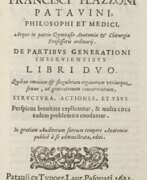

Francesco Plazzoni was an Italian physician and anatomist.
Plazzoni was a fellow student of Fabrizi and colleague of Spigellius, and taught in Padua. He is the author of the treatise De partibus generationi inservientibus libri duo (Padua, 1621). His text is based on Plazzoni's anatomical lectures in Padua and deals with the physiology of the penis, the clitoris, and sexual arousal.


Jean Rey was a French chemist and physician.
Rey received a Master of Arts degree from the Academy of Montauban, then a doctorate from the University of Montpellier, and worked as a physician in his hometown of Le Bug. He was also engaged in chemical research, corresponded with R. Descartes, M. Mersenne and others.
Jean Rey was the first to express the idea of conservation of mass as applied to chemical reactions. While conducting experiments in his brother's forge, he discovered that the mass of lead and tin increases with calcination. The researcher explained this based on the assumption that air has mass and that lead and tin combine with air during calcination. In 1630 Rey published a treatise on this topic, "Experiments to find the reasons for the increase in the weight of tin and lead during calcination". As can be seen from the treatise, he realized that substances are made up of particles. His discovery of the weight of air also made possible the invention of the Torricelli barometer in 1643. Jean Rey also developed a device called the thermoscope, a precursor to the thermometer.


Giuseppe Rosaccio was an Italian physician, astronomer, cosmographer and cartographer.
Rosaccio graduated from the University of Padua, studied philosophy, medicine and law, and worked as a physician and judge. He became famous for a series of works that popularized a number of scientific disciplines. Some of his books deal with astrological medicine, specific diseases and their remedies, and the distillation of medicines from plants.
Giuseppe Rosaccio wrote about forty works on various topics of interest to him, but the main one was geography. He wrote an essay on the Muslim religion and treatises on geography, cosmography, astronomy, and astrology, which became very popular and were repeatedly reprinted.
Rosaccio created many atlases and small-format geographical works. Among his works is Ptolemy's Geography, which contains many indexes and is written in Italian (1599). He also authored a large map of the world (1597), and a large map of Italy and Tuscany (1609). His book Journey from Venice to Constantinople includes maps of the route with brief texts, that is, it is essentially an illustrated version of a pilgrimage to the Holy Land.


Giovanni Dominico Santorini was an Italian anatomist and professor.
Santorini studied medicine in Bologna, Padua and Pisa, earning his doctorate. One of his teachers was Marcello Malpighi (1628-1694). In 1703 Santorini began anatomical autopsies and was a demonstrator of anatomy in Venice from 1706 to 1728. In 1728 he became proto-medic and physician to Spedaletto in that city.
He was considered one of the most industrious and meticulous anatomists of the eighteenth century. Santorini's anatomical studies include many muscular and venous structures, cartilage, and glands of the human body. In addition to detailed descriptions of these structures, he also produced magnificent copper plates and illustrations. In 1724, Santorini published Observationes anatomicae ("Anatomical Observations"), a work that included anatomical aspects of the human body.
Giovanni Santorini's work greatly expanded knowledge of human anatomy, and several organs are named after him. Santorini was also a popular pioneer in the teaching of obstetrics.


Johann Jakob Scheuchzer was a Swiss naturalist and geologist, paleontologist and fossil collector.
Scheuchzer studied at the University of Altdorf near Nuremberg, earned a doctorate in medicine at Utrecht University, and studied astronomy. He worked as a teacher, physician, and corresponded extensively with many scientists, writing several papers, including those on Swiss research, weather, geology, and fossils. Scheuchzer collected fossils during his extensive travels. And, as a proponent of diluvialism, he believed that all fossils and layers of the earth were formed by the Flood.
Between 1731 and 1735, Scheuchzer published a massive four-volume work called Physica Sacra, which is essentially a commentary on the Bible. It presented the facts of natural history along with passages of scripture. Thus Physcia Sacra attempted to reconcile the Bible with science.
This book is also called the "Copper Bible" because it contains over 750 magnificent color engravings on copper plates. These engravings are in themselves the pinnacle of engraving from the Baroque period. The illustrations depict scenes with biblical and scientific motifs. They were based on his own cabinet of natural history and other famous European cabinets of rare specimens. The engravings were produced by highly skilled engravers, including Georg Daniel Heumann and Johann August Corwin.
During his lifetime, Johann Jakob Scheuchzer wrote 34 scientific papers and many articles, and he was a member of the Royal Society.
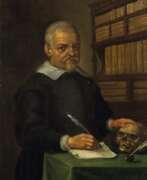

Marco Aurelio Severino was an Italian surgeon, anatomist and zoologist, one of the founders of comparative anatomy.
From childhood Severino studied Latin, Greek, rhetoric, poetry and law in various schools in Calabria, then continued his studies in Naples, soon moving from law to medicine. In Naples he met Tommaso Campanella, who had a great influence on the formation of his worldview. After receiving a medical degree in Salerno in 1606, he studied surgery in Naples with Giulio Jasolino. In 1615 Severino was appointed the first surgeon at Ospedale degli Incurabili. Severino made significant contributions to the transformation of naturophilosophy, medical and surgical practice, to which much of his printed work is devoted.
Severino's main contribution, however, lies in his anatomical works, especially the Zootomia Democritea. This work may be called the earliest comprehensive treatise on comparative anatomy. Severino is considered one of the pioneers of comparative anatomy.
Severino's cultural interests extended far beyond medicine. He corresponded with many prominent physicians and scientists of his time, including William Harvey and John Houghton in England, Thomas Bartolin and Ole Worm in Denmark, J.G. Volkamer and Johannes Wesling in Germany, and Campanella, Jasolino, and Tommaso Cornelio in Italy. Severino was tried by the Inquisition for allegedly unorthodox religious and philosophical views, but was eventually acquitted. He died of the plague in Naples.


Israël Spach (also Israelis Spachius) was a German and French physician, medical writer and teacher of medicine.
Spach studied at the University of Tübingen, receiving the degree of doctor of medicine, and from 1589 taught medicine and Hebrew at the University of Strasbourg, with the rank of professor of medicine. He was characterized by a high bibliographical education.
Spach was the author of a gynecological encyclopedia, Gynaeciorum sive de mulierum tum communibus, tum gravidarum, parientium, et puerperarum affectibus et morbis, published in Strasbourg in 1597. It was a very significant book for its time.
Israël Spach also wrote Nomenclator scriptorum medicorum..., published in Frankfurt in 1591, which was the first attempt at a bibliography on medical subjects. It was organized under very broad subject headings, with indexes of authors and subjects.


Jan Swammerdam was a Dutch naturalist and biologist, anatomist and microscopist.
Swammerdam graduated from the Faculty of Medicine at Leiden University, then studied in Paris, earning a doctorate in medicine, and devoted himself exclusively to microscopic research. He used a single-lens microscope to study insect anatomy, and accurately described and illustrated the life history and anatomy of many species. His observations of their development allowed him to divide insects into four major divisions according to the degree and type of metamorphosis. His greatest contribution to biology was to understand insect development and to demonstrate that the same organism persists through different stages.
Jan Swammerdam wrote a voluminous work entitled A General History of Insects (1669) and The Bible of Nature (1737-1738), one of the finest collections of microscopic observations ever published. Considered the most accurate of the classical microscopists, he was the first to observe and describe erythrocytes in 1658.
Swammerdam was also a recognized anatomist: in 1670 he was granted the privilege of dissecting human bodies in Amsterdam, which at the time required a special license available only to a limited number of researchers. He developed a new dissection technique and also designed several new instruments.


Antonio Vallisneri the Elder was an Italian naturalist, physician and geologist, collector, and member of the Royal Society of London.
He studied in Bologna, Venice, Padua and Parma and headed the chair first of practical medicine and then of theoretical medicine at the University of Padua. In addition to medicine, Vallisneri conducted important research in the natural sciences. In particular, in the field of geology, he is credited with recognizing the organic nature of fossils unrelated to the Great Flood, which contributed to the end of centuries-old disputes. His observations on the water cycle, thermal waters and some mines in the Apennines were also important.
Vallisneri was interested in all branches of the natural sciences, collecting numerous collections of animals, minerals, and other natural objects during his lifetime. The scientist compiled a brief catalog of his collection, which was published in 1733 by his son, Antonio Vallisneri, Jr. The Vallisneri Museum included naturalistic finds, anatomical preparations, medical and scientific instruments, antiques, and exotics from various cultures and eras as well as geographical origins. In 1734, his son donated this museum to the University of Padua, initiating the creation of a general museum for the university.
Antonio Vallisneri Jr. followed in his father's footsteps and for many years held the position of professor of natural history at the University of Padua. He devoted his life to collecting and processing his father's writings and tidying up his library, which contained about a thousand volumes. These were donated to the University Library in Padua.


Adriaan van den Spiegel (or Spieghel), name sometimes written as Adrianus Spigelius, was a Flemish anatomist born in Brussels. For much of his career he practiced medicine in Padua, and is considered one of the great physicians associated with the city. At Padua he studied anatomy under Girolamo Fabrici.
His best written work on anatomy is De humani corporis fabrica libri X tabulis aere icisis exornati, published posthumously in 1627. In his 1624 treatise De semitertiana libri quatuor, he gave the first comprehensive description of malaria.


Georg Hieronymus Welsch (or Welschius) was a German physician, translator and writer.
He studied medicine in Tübingen, Strasbourg and Padua. Having lost the ability to speak as a result of illness, he decided to settle in Augsburg and educate himself. Welsch studied Greek, Latin, Hebrew and Arabic. Then in Italy he visited numerous libraries, including the Vatican library, and collected books, including the Turkish calendar.
Georg Welsch wrote several books on medicine and fossil curiosities, and researched texts on astronomy and medicine from the Ottoman Empire. He is best known for his translation of the calendar of Avicenna and Sheikh Abul-Wafa. Welsch was also a member of the Academia Naturae Curiosorum.














